Full Text Searchable PDF User Manual

S
ERVICE
M
ANUAL
& PARTS LIST
(WITHOUT PRICE)
QW-2960
MODULE NO.
R
REF. NO. S/M-900
JUL. 2005
BGX-260

CONTENTS
Page
1. SPECIFICATIONS: MODULE QW-2960 .................................................... 1
2. OPERATION CHART: MODULE QW-2960 ............................................... 2
3. DRAWINGS: MODULE QW-2960
3-1. LCD DIAGRAM ............................................................................................. 8
3-2. CIRCUIT DIAGRAM ...................................................................................... 9
3-3. CHECKING TERMINALS AND COMPONENTS ......................................... 10
4. EXPLODED VIEW: MODULE QW-2960 ................................................... 11
5. PARTS LIST: MODULE QW-2960 ............................................................ 12
6. PRECAUTIONS FOR REPAIR: MODULE QW-2960
6-1. AC (ALL CLEAR) AND REMOVING OF MODULE ..................................... 13
6-2. ACCURACY CHECKING ............................................................................. 13
6-3. SOLAR CELL-PCB ASS'Y CONTACT CHECKING .................................... 14
6-4. HOW TO CHECK TILT SENSOR................................................................. 14
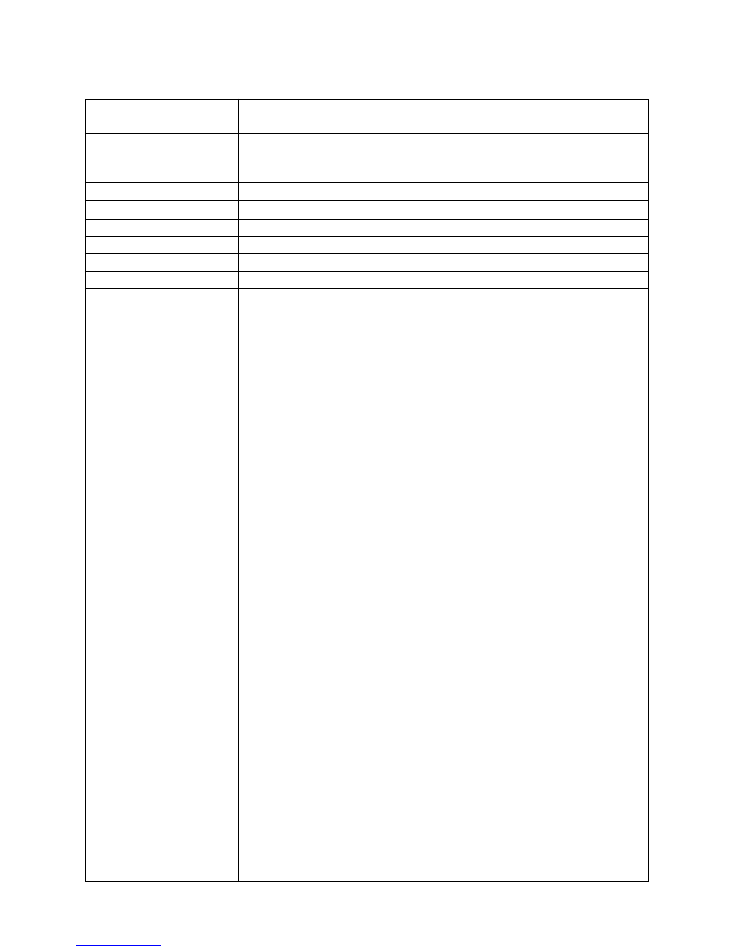
— 1 —
1. SPECIFICATIONS: MODULE QW-2960
Battery
CTL1616 (Storage battery)
Note: Use CTL1616 only. Other storage battery or CR1616 can cause
damage to the watch.
Battery life
Approx. 1 year (from full charged condition)
Current consumption
1.05
µ
A maximum
Alarm system
Piezo plate on Cover/Back
Accuracy
±
15 sec./month
Accuracy setting system
Trimmer capacitor
Accuracy checking
See page 13
Item
Detail
Functions
• Shock resistant
• Electro-luminescent backlight
Full auto EL light
• Solar powered
• World time
29 time zones (27 cities), city code display, daylight saving on/off
• Moon Data (with Moon age indicator)
• Tide graph
Graphical tide display
• 1/100-second stopwatch
Measuring capacity: 59'59.99"
Measuring modes: Elapsed time, split time, 1st-2nd place times
• Countdown timer
Measuring unit: 1 second
Countdown range: 60 minutes
Countdown start time setting range: 1 to 60 minutes (1-minute Increments)
Others: Auto-repeat, time up alarm, reset time setting (up to 5 minutes),
count up after countdown (up to 100 hours)
• Daily alarms
5 independent daily alarms (4 one-time alarms and 1 snooze alarm)
• Hourly time signal
• Battery power indicator
• Power Saving (Turns off the display when the watch is left in the dark)
• Auto-calendar (to year 2039)
• 12/24-hour format
• Regular timekeeping: Hour, minutes, seconds, pm, year, month, date, day
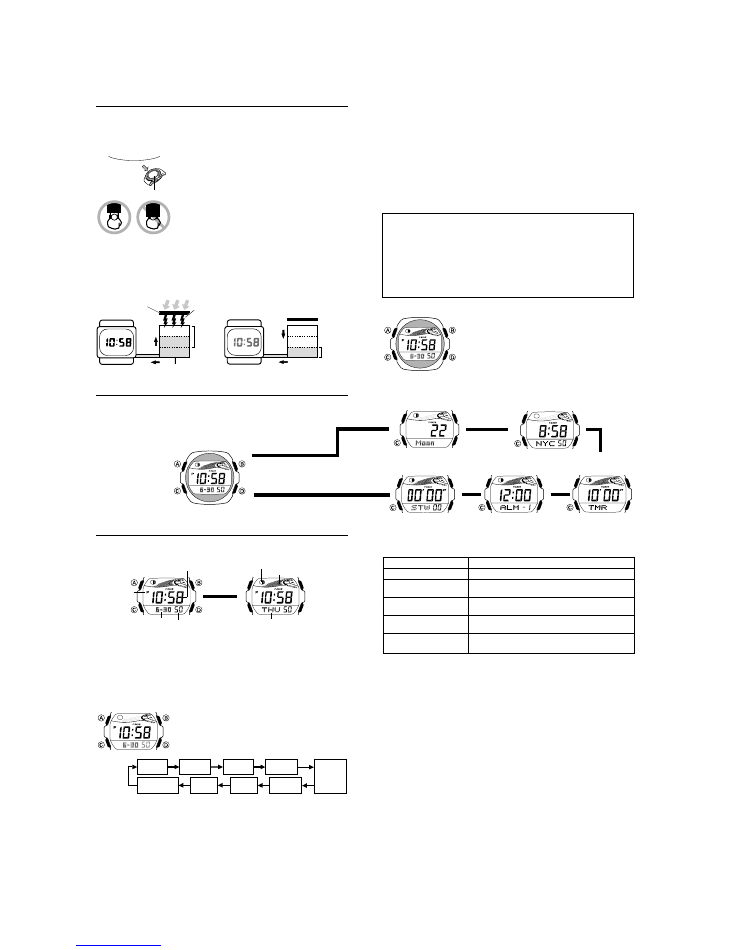
— 2 —
2. OPERATION CHART: MODULE QW-2960
Getting Acquainted
Congratulations upon your selection of this CASIO watch. To get the most out of your
purchase, be sure to read this manual carefully and keep it on hand for later reference
when necessary.
Keep the watch exposed to bright light
The electricity generated by the solar cell of the watch is
stored by a built-in battery. Leaving or using the watch
where it is not exposed to light causes the battery to run
down. Make sure the watch is exposed to light as much as
possible.
•
When you are not wearing the watch on your wrist,
position the face so it is pointed at a source of bright
light.
•
You should try to keep the watch outside of your sleeve
as much as possible. Even if the face of the watch is
only partially blocked from light, charging will be reduced
significantly.
l
l
l
l
l
l
l
l
l
l
l
Bright Light
Solar cell
•
The watch continues to operate, even when it is not exposed to light. Leaving the
watch in the dark can cause the battery to run down, which will cause some watch
functions to be disabled. If the battery goes dead, you will have to re-configure watch
settings after recharging. To ensure normal watch operation, be sure to keep it
exposed to light as much as possible.
Bright Light
Electrical
energy
All
functions
enabled
LEVEL 1
LEVEL 2
LEVEL 3
Charge
Solar cell
(Converts light to
electrical power.)
Rechargeable battery
LEVEL 1
LEVEL 2
LEVEL 3
Some
functions
disabled
Dis-
charge
Battery charges in the light.
Battery discharges in the dark.
•
The actual level at which some functions are disabled depends on the watch model.
•
Frequent display illumination can run down the battery quickly and require charging.
The following guidelines give an idea of the charging time required to recover from a
single illumination operation.
Approximately 5 minutes exposure to bright sunlight coming in through a window
Approximately 50 minutes exposure to indoor fluorescent lighting
•
Be sure to read “Power Supply” for important information you need to know
when exposing the watch to bright light.
If the display of the watch is blank...
If the display of the watch is blank, it means that the watch’s Power Saving function
has turned off the display to conserve power.
•
See “Power Saving Function” for more information.
Warning!
•
The longitude, lunitidal interval, Moon phase indicator and tide graph data that
appear on the display of this watch are not intended for navigation purposes.
Always use proper instruments and resources to obtain data for navigation
purposes.
•
This watch is not an instrument for calculating low tide and high tide times. The
tide graph of this watch is intended to provide a reasonable approximation of tidal
movements only.
•
CASIO COMPUTER CO., LTD. assumes no responsibility for any loss, or any
claims by third parties that may arise through the use of this watch.
About This Manual
•
Button operations are indicated using the letters shown
in the illustration.
•
Each section of this manual provides you with the
information you need to perform operations in each
mode. Further details and technical information can be
found in the “Reference” section.
Moon / Tide Data Mode
World Time Mode
Stopwatch Mode
Timekeeping Mode
▲
▲
▲
Countdown Timer
Mode
▲
▲
Alarm Mode
Press
C
.
▲
General Guide
•
Press
C
to change from mode to mode.
•
In any mode (except when a setting screen is on the display), press
B
to illuminate
the display.
Timekeeping
Use the Timekeeping Mode to set and view the current time and date.
•
The tide graph shows tidal movements for the current date in accordance with the
current time as kept in the Timekeeping Mode.
•
The Moon phase indicator shows the current Moon phase in accordance with the
current date as kept in the Timekeeping Mode.
Day of week
Month – Day
Hour : Minutes
PM indicator
Seconds
Press
D
.
▲
▲
Month-Day Screen
Day of the Week Screen
Tide graph
Moon phase indicator
Important!
•
Moon phase, tide graph data, and Moon/Tide Data Mode data will not be displayed
properly unless the Timekeeping Mode current date and time settings and Home
Site data are configured correctly. See “Home Site Data” for more information.
To set the time and date
1. In the Timekeeping Mode, hold down
A
until the
seconds start to flash, which indicates the setting
screen.
2. Press
C
to move the flashing in the sequence shown
below to select other settings.
|
| |
|
|
||
||
|
|
| |
DST on/off
Seconds
12/24-Hour
Format
Power Saving
Day
Month
Year
Hour
Minutes
3. When the setting you want to change is flashing, use
D
and
B
to change it as
described below.
To change this setting
Seconds
DST on/off
Hour, Minutes, Year,
Month, Day
12/24-Hour Format
Power Saving
Perform this button operation
Press
D
to reset to
00
.
Press
D
to toggle between Daylight Saving Time
(
ON
) and Standard Time (
OF
).
Use
D
(+) and
B
(–) to change the setting.
Press
D
to toggle between 12-hour (
12H
) and
24-hour (
24H
) timekeeping.
Press
D
to toggle Power Saving on (
ON
) and off
(
OF
).
4. Press
A
twice to exit the setting screen.
•
The first press of
A
displays the GMT differential setting screen. Pressing
A
again
exits the setting screen.
•
Daylight Saving Time (summer time) advances the time setting by one hour from
Standard Time. Remember that not all countries or even local areas use Daylight
Saving Time.
•
The DST indicator appears on the display to indicate that Daylight Saving Time is
turned on.
•
See “Power Saving Function” for details about configuring Power Saving settings.
•
The 12-hour/24-hour timekeeping format you select in the Timekeeping Mode is
applied in all modes.
•
The day of the week is automatically displayed in accordance with the date (year,
month, and day) settings.
Home Site Data
Moon phase, tide graph data, and Moon/Tide Data Mode data will not be displayed
properly unless the Timekeeping Mode current date and time settings and Home Site
data (GMT differential, longitude, and lunitidal interval) is configured correctly.
•
The GMT differential is the time difference of the time zone where the site is located
and Greenwich Mean Time.
•
The lunitidal interval is the time elapsing between the Moon’s transit over a meridian
and the next high tide at that meridian. See “Lunitidal Interval” for more information.
•
This watch displays lunitidal intervals in terms of hours and minutes.
•
The “Site/Lunitidal Interval Data List” provide GMT differential, longitude, and
lunitidal interval information around the world.
•
The following is the initial factory default Home Site data (Tokyo, Japan) when you
first purchase the watch, whenever battery power drops to Level 4, and whenever
you have the battery replaced. Change these settings to match the area where you
normally use the watch.
GMT differential (+9.0); Longitude (East 140 degrees); Lunitidal interval (5 hours,
20 minutes)
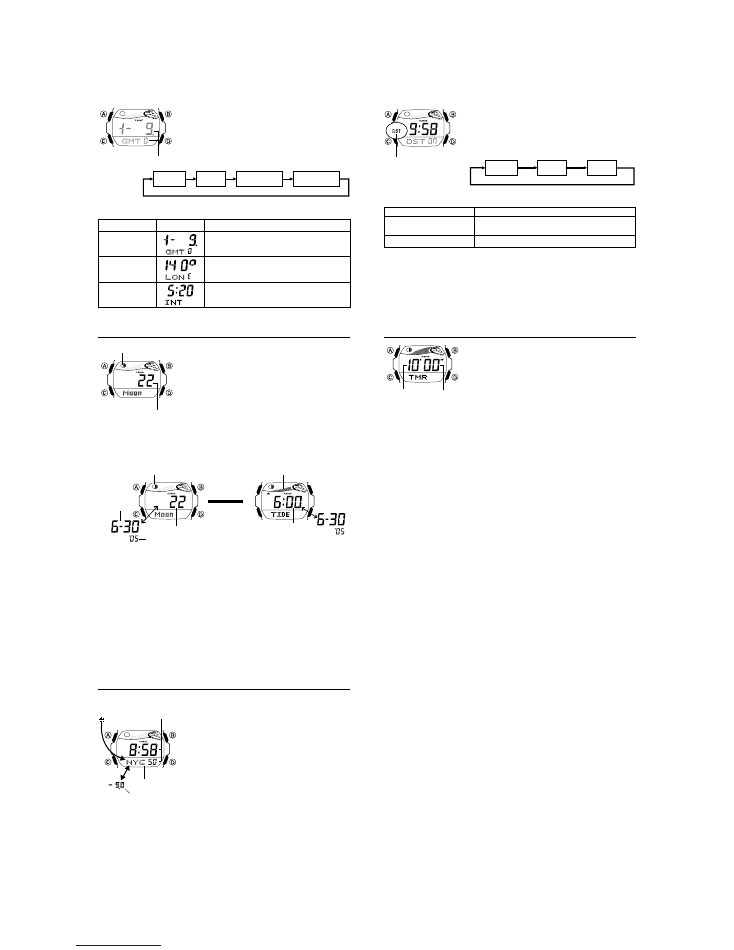
— 3 —
To configure Home Site data
1. In the Timekeeping Mode, hold down
A
until the
seconds start to flash, which indicates the setting
screen.
2. Press
A
again to display the GMT differential setting
screen.
3. Press
C
to move the flashing in the sequence shown
below to select other settings.
Lunitidal Interval
Hours
Lunitidal Interval
Minutes
Longitude
GMT
differential
4. When the setting you want to change is flashing, use
D
and
B
to change it as
described below.
l l l
l l
l
l
ll
ll
ll
ll
ll
ll
l
l
l l
l l
l l l l
GMT differential
Setting
GMT differential
Longitude
Lunitidal Interval
Hours, Minutes
Screen
Button Operations
Use
D
(+) and
B
(–) to change the setting.
•
You can specify a value in the range of –11.0
to +14.0, in 0.5-hour unit.
Use
D
(+) and
B
(–) to change the setting.
•
You can specify a value in the range of
179
°
W to 180
°
E, in 1-degree units.
Use
D
(+) and
B
(–) to change the setting.
5. Press
A
to exit the setting screen.
Moon/Tide Data
Moon/tide data lets you view the Moon age and Moon
phase for a particular date, and tidal movements for a
particular date and time for the Home Site.
•
If you suspect that the Moon/tide data is not correct for
some reason, check the Timekeeping Mode data
(current time, date, and Home Site settings), and make
changes as required.
•
See “Moon Phase Indicator” for information about the
Moon phase indicator and “Tide Graph” for information
about the tide graph.
•
All of the operations in this section are performed in the
Moon/Tide Data Mode, which you enter by pressing
C
.
Moon phase indicator
Moon age
Moon/Tide Data Screens
Each press of
A
in the Moon/Tide Data Mode toggles between the Moon Data
screen and the Tide Data screen.
•
When you enter the Moon/Tide Data Mode, the data that appears first is the Moon
data (Moon age and Moon phase indicator) for the current date as kept by the
Timekeeping Mode.
Press
A
.
Tide Data Screen
Moon Data Screen
Tide graph
Time
Moon age
Moon phase indicator
▲
▲
Month – Day
Year
To view the Moon data for a particular date
While the Moon Data screen is displayed in the Moon/Tide Data Mode, use
D
(+) to
display the date whose Moon data you want to view.
•
You can select any date starting from the date currently indicated in the Timekeeping
Mode, up to the year 2039. Display of past Moon data and tide data is not supported.
To view tide data for a particular time
1. While the Moon Data screen is displayed in the Moon/Tide Data Mode, use
D
(+)
to display the date whose tide data you want to view.
2. Press
A
to switch to the Tide Data screen.
•
The initial screen shows the tide graph for 6:00 AM.
3. Specify the time for which you want to display tide data.
•
Use
D
(+) to change the time in one-hour steps.
World Time
The World Time shows the current time in 27 cities (29
time zones) around the world.
•
The time settings of the Timekeeping Mode and the
World Time Mode are independent from each other, so
you must make separate settings for each.
•
Whenever you change the time setting for any city in the
World Time Mode, the settings of all other cities are
changed accordingly.
•
For full information on city codes, see the “City Code
Table”.
•
All of the operations in this section are performed in the
World Time Mode, which you enter by pressing
C
.
Current time in
the selected city
code
City code
WT
GMT differential
To view the time in another city code
In the World Time Mode, press
D
to scroll through city codes (time zones).
To set the current time in the World Time Mode
1. In the World Time Mode, use
D
to select the city code
whose time you want to set.
2. After you select a city code, hold down
A
until the DST
on/off setting of the world time starts to flash, which
indicates the setting screen.
3. Use
C
to move the flashing in the sequence shown
below to select other settings.
l l lll
ll
ll
ll
ll
lll
l l l l l l l
DST indicator
Hour
DST on/off
Minutes
4. When the setting you want to change is flashing, use
B
and
D
to change it as
described below.
•
When setting the world time using the 12-hour format, take care to set the time
correctly as a.m. (no indicator) or p.m. (P indicator).
5. Press
A
to exit the setting screen.
• Note that you cannot switch between Standard Time and Daylight Saving Time while
GM
T
is selected as the city code.
• Note that the DST/Standard Time setting affects only the currently displayed city
code. Other city codes are not affected.
• The DST indicator is on the display whenever you display a city code for which
Daylight Saving Time is turned on.
To change this setting
DST on/off
Hour, Minutes
Perform this button operation
Press
D
to toggle between Daylight Saving Time
(
ON
) and standard time (
OF
).
Use
D
(+) and
B
(–) to change the setting.
Countdown Timer
The countdown timer can be set within a range of one
minute to 60 minutes. An alarm sounds when the
countdown reaches zero. The countdown timer has two
modes: auto-repeat and elapsed time, and a progress
beeper signals the progress of the countdown. All of this
makes the countdown timer a valuable tool for timing the
start of a surfing or a yacht race.
•
All of the operations in this section are performed in the
Countdown Timer Mode, which you enter by pressing
C
.
Configuring the Countdown Timer
The following are the settings you should configure before actually using the
countdown timer.
Countdown start time and reset time
Timer mode (auto-repeat, elapsed time)
Progress beeper on/off
Minutes
Seconds
•
See “To configure the countdown timer” for information about setting up the timer.
Reset Time
You can specify any point between the countdown start time and the end of the
countdown as the “reset time”. Then while a countdown operation is in progress, you
can press a button to jump to the reset time and resume the countdown from there.
Timer Mode
The countdown timer gives you a choice of two modes: auto-repeat and elapsed time.
Auto-repeat
The auto-repeat mode automatically restarts the countdown from the countdown start
time you set whenever zero is reached.
•
The auto-repeat mode is best when timing the starts of match races.
•
Even if you start a countdown operation from the reset time, the countdown
automatically restarts from the countdown start time whenever it reaches zero.
•
Auto repeat timing repeats up to seven times.
Elapsed Time
When the end of the countdown is reached in the elapsed time mode, the timer
automatically switches to an elapsed time measurement operation.
•
The elapsed time mode is best when timing the speed of yachts during ocean races.
•
The elapsed time operation is performed in one-second increments up to 99 hours,
59 minutes, 59 seconds.
Countdown Timer Beeper Operations
The watch beeps at various times during a countdown so you can keep informed
about the countdown status without looking at the display. The following describes the
types of beeper operations the watch performs during a countdown.
Countdown End Beeper
The watch emits a short beep each second of the final 10 seconds at the end of a
countdown, and a long beep when the countdown reaches zero.
•
The countdown end beeper always sounds, regardless of the on/off status of the
progress beeper.
Progress Beeper
The progress beeper actually includes two beepers: a reset time beeper and a reset
period progress beeper.
•
The reset time beeper and reset period progress beeper sound only while the
progress beeper is turned on.
Reset Time Beeper
The reset time beeper is similar to the countdown end beeper. When the progress
beeper is turned on, the watch beeps each second of the final 10 seconds before the
countdown reaches the reset time.
Reset Period Progress Beeper
The reset period is the portion of the countdown between the reset time and zero.
When the progress beeper is turned on, the watch emits four short beeps at the top of
each minute during the reset period, and 30 seconds before the end of the
countdown.
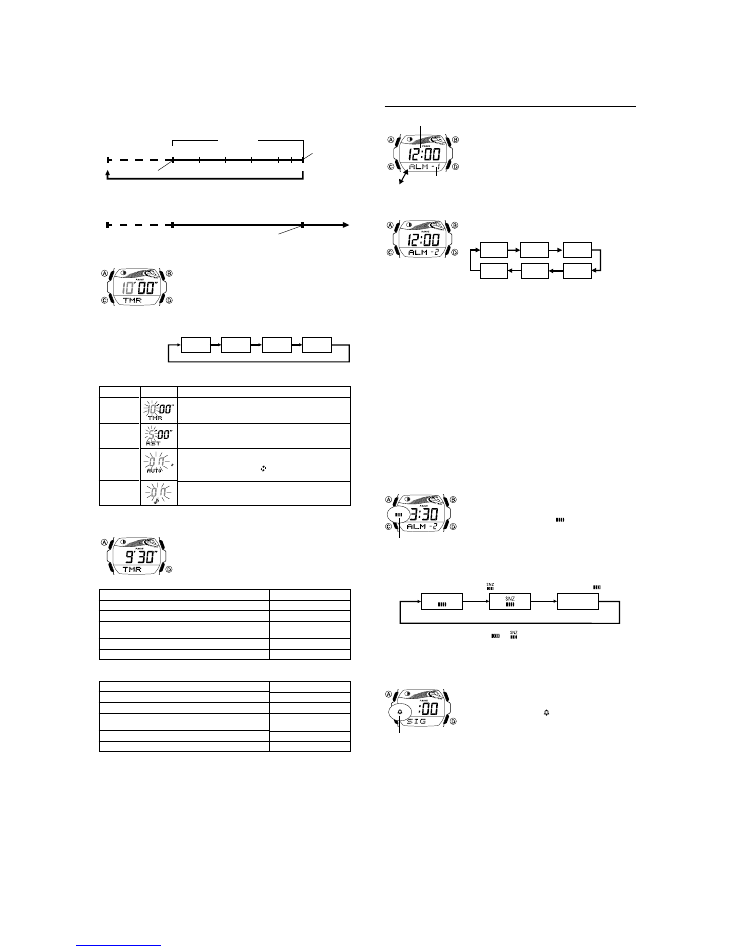
— 4 —
Countdown Timer Examples
Countdown start time: 10 minutes; Reset time: 5 minutes; Timer mode: Auto-repeat;
Progress beeper: On
10'00"
Start Time
Reset Time
0'00"
1'00" 0'30"
2'00"
3'00"
4'00"
5'00"
Reset Period
Reset Period Progress Beeper
Countdown
End Beeper
Reset Time Beeper
Countdown start time: 10 minutes; Reset time: 5 minutes; Timer mode: Elapsed time;
Progress beeper: Off
10'00"
0'00"
5'00"
Countdown
End Beeper
Elapsed time
measurement
Start Time
Reset Time
To configure the countdown timer
1. While the countdown start time is on the display in the
Countdown Timer Mode, hold down
A
until the
countdown start time setting starts to flash, which
indicates the setting screen.
•
If the countdown start time is not displayed, use the
procedure under “To use the countdown timer” to
display it.
2. Press
C
to move the flashing in the sequence shown
below to select other settings.
Start
Time
Reset
Time
Timer
Mode
Progress
Beeper
3. When the setting you want to change is flashing, use
D
and
B
to change it as
described below.
|
|
|
||
||
|
|
| | |
Setting
Start Time
Reset Time
Timer
Mode
Progress
Beeper
Screen
Button Operations
Use
D
(+) and
B
(–) to change the setting.
•
You can set a start time in the range of 1 to 60 minutes
in 1-minute increments.
Use
D
(+) and
B
(–) to change the setting.
•
You can set a reset time in the range of 1 to 5 minutes
in 1-minute increments.
Press
D
to toggle between the auto-repeat mode (
ON
)
and the elapsed time mode (
OFF
).
•
An auto-repeat indicator (
) appears when the auto-
repeat mode is selected.
Press
D
to toggle progress beeper on (
ON
) and off (
OFF
).
4. Press
A
to exit the setting screen.
•
The reset time setting must be less than the countdown start time setting.
To use the countdown timer
In the Countdown Timer Mode, press
D
to start the
countdown timer.
•
The countdown timer measurement operation continues
even if you exit the Countdown Timer Mode.
•
The table below describes button operations you can
perform to control countdown operations.
To do this:
Stop the countdown operation
Resume a stopped countdown operation
Display the countdown start time
Stop the countdown operation and display the reset time
Start the countdown from the displayed reset time
Do this:
Press
D
.
Press
D
again.
While the countdown is
stopped, press
A
.
Press
A
.
Press
D
.
•
The table below describes button operations you can perform during an elapsed
time measurement operation in the elapsed time mode.
To do this:
Stop the elapsed time operation
Resume a stopped elapsed time operation
Display the countdown start time
Stop the elapsed time operation and display the reset time
Start the countdown from the displayed reset time
Do this:
Press
D
.
Press
D
again.
While the elapsed time is
stopped, press
A
.
Press
A
.
Press
D
.
To set an alarm time
1. In the Alarm Mode, use
D
to scroll through the alarm
screens until the one whose time you want to set is
displayed.
•
You can configure Alarm
1
as a snooze alarm or a one-time alarm. Alarms
2
through
5
can be used as one-time alarms only.
•
The snooze alarm repeats every five minutes.
2. After you select an alarm, hold down
A
until the hour setting of the alarm time
starts to flash. This indicates the setting screen.
•
This operation automatically turns on the alarm.
-3
-4
-1
-2
:00
-5
3. Press
C
to move the flashing between the hour and minute settings.
4. While a setting is flashing, use
D
(+) and
B
(–) to change it.
•
When setting the alarm time using the 12-hour format, take care to set the time
correctly as a.m. (no indicator) or p.m. (P indicator).
5. Press
A
to exit the setting screen.
Alarm Operation
The alarm sounds at the preset time for about 10 seconds. In the case of the snooze
alarm, the alarm operation is performed a total of seven times, every five minutes, or
until you turn the alarm off or change it to a one-time alarm.
Note
•
Pressing any button stops the alarm tone operation.
•
Performing any one of the following operations during a 5-minute interval between
snooze alarms cancels the current snooze alarm operation.
Displaying the Timekeeping Mode setting screen
Displaying the Alarm
1
setting screen
To test the alarm
In the Alarm Mode, hold down
D
to sound the alarm.
To turn Alarms
2
through
5
on and off
1. In the Alarm Mode, use
D
to select a one-time alarm
(alarm number
2
through
5
).
2. Press
A
to toggle the displayed alarm on and off.
•
Turning on a one-time alarm (
2
through
5
) displays the
one-time alarm on indicator (
) on its screen.
•
If any alarm is on, the one-time alarm on indicator is
shown on the display in all modes.
One-time alarm on
indicator
To select the operation of Alarm
1
1. In the Alarm Mode, use
D
to select Alarm
1
.
2. Press
A
to cycle through the available settings in the sequence shown below.
Snooze alarm on indicator ( ) and one-time alarm on indicator ( )
One-time alarm on
Snooze alarm on
Alarm off
•
The applicable alarm on indicator (
or
) is displayed in all modes when an
alarm is turned on.
•
SNZ indicator flashes during the 5-minute intervals between alarms.
•
Displaying the Alarm
1
setting screen while the snooze alarm is turned on
automatically turns off the snooze alarm (making Alarm
1
a one-time alarm).
To turn the hourly time signal on and off
1. In the Alarm Mode, use
D
to select the Hourly Time
Signal.
2. Press
A
to toggle it on and off.
•
Turning on the Hourly Time Signal causes the hourly
time signal on indicator (
) to be displayed in all
modes.
Hourly time signal on
indicator
Alarms
You can set five independent Daily Alarms. When an
alarm is turned on, the alarm tone sounds when the alarm
time is reached. One of the alarms can be configured as a
snooze alarm or a one-time alarm, while the other four are
one-time alarms.
You can also turn on an Hourly Time Signal that causes
the watch to beep twice every hour on the hour.
•
There are five alarm screens numbered
1
through
5
.
The hourly time signal screen is indicated by :
00
.
•
When you enter the Alarm Mode, the screen you were
viewing when you last exited the mode appears first.
•
All of the operations in this section are performed in the
Alarm Mode, which you enter by pressing
C
.
Alarm number
Alarm time
(Hour : Minutes)
SNZ
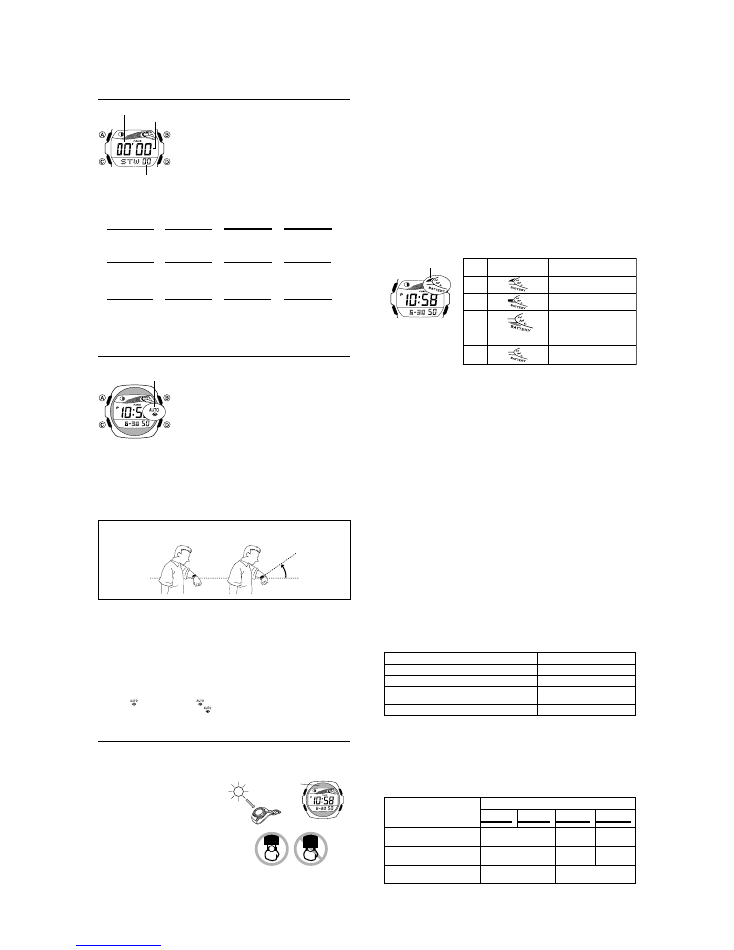
— 5 —
Backlight
The backlight uses an EL (electro-luminescent) panel that
causes the entire display to glow for easy reading in the
dark. The watch’s auto light switch automatically turns on
the backlight when you angle the watch towards your face.
•
The auto light switch must be turned on (indicated by
the auto light switch on indicator) for it to operate.
•
See “Backlight Precautions” for other important
information about using the backlight.
To turn on the backlight manually
In any mode (except when a setting screen is on the
display), press
B
to illuminate the display for about one
second.
•
The above operation turns on the backlight regardless of
the current auto light switch setting.
Auto light switch
on indicator
About the Auto Light Switch
Turning on the auto light switch causes the backlight to turn on for about one second,
whenever you position your wrist as described below in any mode. Note that this
watch features a “Full Auto EL Light,” so the auto light switch operates only when
available light is below a certain level. It does not turn on the backlight under bright
light.
Moving the watch to a position that is parallel to the ground and then tilting it towards
you at more than 40 degrees causes the backlight to turn on.
Parallel to
ground
More than
40
°
Warning!
•
Always make sure you are in a safe place whenever you are reading the
display of the watch using the auto light switch. Be especially careful when
running or engaged in any other activity that can result in accident or injury.
Also take care that sudden illumination by the auto light switch does not
startle or distract others around you.
•
When you are wearing the watch, make sure that its auto light switch is turned
off before riding on a bicycle or operating a motorcycle or any other motor
vehicle. Sudden and unintended operation of the auto light switch can create a
distraction, which can result in a traffic accident and serious personal injury.
To turn the auto light switch on and off
In the Timekeeping Mode, hold down
D
for about two seconds to toggle the auto light
switch on (
displayed) and off (
not displayed).
•
The auto light switch on indicator (
) is on the display in all modes while the auto
light switch is turned on.
Power Supply
This watch is equipped with a solar cell and a special rechargeable battery (secondary
battery) that is charged by the electrical power produced by the solar cell. The
illustration shown below shows how you should position the watch for charging.
Example: Orient the watch so its face
is pointing at a light source.
•
The illustration shows how to position a
watch with a resin band.
•
Note that charging efficiency drops
when any part of the solar cell is
blocked by clothing, etc.
•
You should try to keep the watch
outside of your sleeve as much as
possible. Even if the face of the watch
is only partially blocked from light,
charging will be significantly reduced.
Solar cell
Important!
•
Storing the watch for long periods in an area where there is no light or wearing it in
such a way that it is blocked from exposure to light can cause rechargeable battery
power to run down. Make sure that the watch is normally exposed to bright light
whenever possible.
•
This watch uses a special rechargeable battery to store power produced by the solar
cell, so regular battery replacement is not required. However, after very long use, the
rechargeable battery may lose its ability to achieve a full charge. If you experience
problems getting the special rechargeable battery to fully charge, contact your
dealer or CASIO distributor about having it replaced.
•
Never try to remove or replace the watch’s special battery yourself. Use of the wrong
type of battery can damage the watch.
•
The current time and all other settings return to their initial factory defaults whenever
battery power drops to Level 4 and when you have the battery replaced.
•
Turn on the watch’s Power Saving function and keep it in an area normally exposed
to bright light when storing it for long periods. This helps to keep the rechargeable
battery from going dead.
Battery Power Indicator
The battery power indicator on the display shows you the current status of the
rechargeable battery’s power.
Battery power indicator
Level
1
2
3
4
Battery Power
Indicator
| ||
||
||
||
| | | |
(Charge Soon Alert)
Function Status
All functions enabled.
All functions enabled.
Beeper tone, backlight,
display, and buttons are
disabled.
All functions, including
timekeeping, are disabled.
•
The flashing CHARGE indicator at Level 3 tells you that battery power is very low,
and that exposure to bright light for charging is required as soon as possible.
•
At Level 4, all functions are disabled and settings return to their initial factory
defaults. Functions are enabled once again after the rechargeable battery is
charged, but you need to set the time and date, after the battery reaches Level 3
(indicated by flashing CHARGE indicator) from Level 4. You will not be able to set
any of the other settings until the battery reaches Level 2 (no CHARGE indicator)
after dropping to Level 4.
•
Leaving the watch in direct sunlight or exposed to some other very strong light
source can cause the battery power indicator to temporarily show a reading that is
higher than the actual battery level. The correct battery power indicator should
appear after a few minutes.
•
If you use the backlight or any of the alarm functions a number of times during a
short period, RECOVER appears on the display and the following operations
become disabled until battery power recovers.
Backlight
Beeper tone
After some time, battery power will recover and RECOVER will disappear, indicating
that the above functions are enabled again.
Charging Precautions
Certain charging conditions can cause the watch to become very hot. Avoid leaving
the watch in the areas described below whenever charging its rechargeable battery.
Also note that allowing the watch to become very hot can cause its liquid crystal
display to black out. The appearance of the LCD should become normal again when
the watch returns to a lower temperature.
Warning!
Leaving the watch in bright light to charge its rechargeable battery can cause it
to become quite hot. Take care when handling the watch to avoid burn injury.
The watch can become particularly hot when exposed to the following
conditions for long periods.
•
On the dashboard of a car parked in direct sunlight
•
Too close to an incandescent lamp
•
Under direct sunlight
Charging Guide
After a full charge, timekeeping remains enabled for up to about 12 months.
•
The following table shows the amount of time the watch needs to be exposed to light
each day in order to generate enough power for normal daily operations.
Exposure Level (Brightness)
Outdoor Sunlight (50,000 lux)
Sunlight Through a Window (10,000 lux)
Daylight Through a Window on a Cloudy Day
(5,000 lux)
Indoor Fluorescent Lighting (500 lux)
Approximate Exposure Time
5 minutes
24 minutes
48 minutes
8 hours
•
Since these are the specs, we can include all the technical details.
•
Watch is not exposed to light
•
Display on 18 hours per day, sleep state 6 hours per day
•
1 backlight operation (1.5 seconds) per day
•
10 seconds of alarm operation per day
•
1 countdown timer operation per day
•
Stable operation is promoted by frequent charging.
Exposure Level
(Brightness)
Outdoor Sunlight (50,000 lux)
Sunlight Through a Window
(10,000 lux)
Daylight Through a Window
on a Cloudy Day (5,000 lux)
Approximate Exposure Time
Level 4
Level 3
Level 2
Level 1
▲
▲
▲
90 minutes
6 hours
11 hours
25 hours
126 hours
7 hours
35 hours
– – –
▲
Recovery Times
The table below shows the amount exposure that is required to take the battery from
one level to the next.
•
The above exposure time values are all for reference only. Actual required exposure
times depend on lighting conditions.
Stopwatch
The stopwatch lets you measure elapsed time, split times,
and two finishes.
•
The display range of the stopwatch is 59 minutes, 59.99
seconds.
•
The stopwatch continues to run, restarting from zero
after it reaches its limit, until you stop it.
•
The stopwatch measurement operation continues even
if you exit the Stopwatch Mode.
•
Exiting the Stopwatch Mode while a split time is frozen
on the display clears the split time and returns to
elapsed time measurement.
•
All of the operations in this section are performed in the
Stopwatch Mode, which you enter by pressing
C
.
1/100 second
Minutes
Seconds
To measure times with the stopwatch
D
Start
Stop
Elapsed Time
➤
D
Re-start
Clear
➤
Stop
D
➤
D
➤
A
Split Time
D
Start
Split
➤
Split release
Clear
A
➤
Stop
A
➤
D
➤
A
Two Finishes
D
Start
Split
➤
Stop
Clear
A
➤
Split release
D
➤
A
➤
A
First runner
finishes.
Display time of
first runner.
Second runner
finishes.
Display time of
second runner.
(SPL displayed)
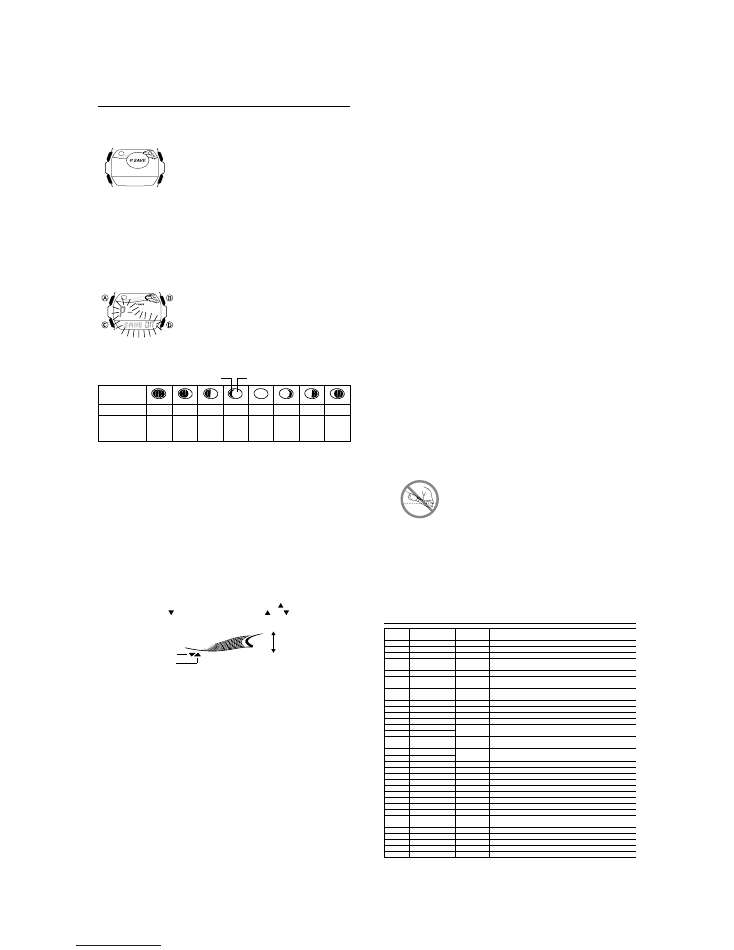
— 6 —
Moon Phase Indicator
The Moon phase indicator of this watch indicates the current phase of the Moon as
shown below.
Moon Phase
Indicator
Moon Age
Moon Phase
0, 1, 29
2 - 5
6 - 9
10 - 13 14 - 16 17 - 20 21 - 24 25 - 28
New
Moon
First
Quarter
(Waxing)
Full
Moon
Last
Quarter
(Waning)
Moon phase (part you can see)
(part you cannot see)
•
The Moon phase indicator shows the Moon as viewed at noon from a position in the
Northern Hemisphere looking south. Note that at times the image shown by the
Moon phase indicator may differ from that of the actual Moon in your area.
•
The left-right orientation of the Moon phase is reversed when viewing from the
Southern Hemisphere or from a point near the equator.
Moon Phases and Moon Age
The Moon goes through a regular 29.53-day cycle during which it appears to wax and
wane due to how the Sun illuminates the Moon and the relative positioning of the
Earth, Moon, and Sun. The greater the angular distance between the Moon and the
Sun,
*
the more we see illuminated.
*
The angle to the Moon in relation to the direction at which the Sun is visible from the
Earth.
The Moon age indicates the number of days from the New Moon to any particular
phase. It is normally calculated using either noon or midnight as a reference point.
This watch calculates the Moon age based on the angular distance of the Moon at
noon, which can result in an error of
±
1 day. Because of this, the appearance of the
Moon phase indicator may be different from that of the actual Moon.
The watch uses the following formula to calculate Moon age.
Moon Age (days) = 29.53
×
(Moon angular distance / 360
°
)
Tide Graph
The wave on the watch’s tide graph indicates the current tide. indicates that the tide
is currently rising, while indicates a falling tide. Neither nor is on the display at
high tide and low tide.
Tidal Movements
Tides are the periodic rise and fall of the water of oceans, seas, bays, and other
bodies of water caused mainly by the gravitational interactions between the Earth,
Moon and Sun. Tides rise and fall about every six hours. The tide graph of this watch
indicates tidal movement based on the Moon’s transit over a meridian and the lunitidal
interval. The lunitidal interval differs according to your current location, so you must
specify a lunitidal interval in order to obtain the correct tide graph readings.
Falling
Rising
High tide
Low tide
Lunitidal Interval
Theoretically, high tide is at the Moon’s transit over the meridian and low tide is about
six hours later. Actual high tide occurs somewhat later, due to factors such as
viscosity, friction, and underwater topography. Both the time differential between the
Moon’s transit over the meridian until high tide and the time differential between the
Moon’s transit over the meridian until low tide are known as the “lunitidal interval.”
When setting the lunitidal interval for this watch, use the time differential between the
Moon’s transit over the meridian until high tide.
See the “Site/Lunitidal Interval Data List” for lunitidal interval information around the
world.
Auto Return Feature
•
If you leave a screen with flashing digits on the display for two or three minutes
without performing any operation, the watch automatically saves any settings you
have made up to that point and exits the setting screen.
•
If you leave the watch in the Moon/Tide Data Mode and Alarm Mode for two or three
minutes without performing any operation, it automatically changes to the
Timekeeping Mode.
Data and Setting Scrolling
The
B
and
D
buttons are used in various modes and setting screens to scroll
through data on the display. In most cases, holding down these buttons during a scroll
operation scrolls through the data at high speed.
Initial Screens
When you enter the Timekeeping, World Time, or Alarm Mode, the data you were
viewing when you last exited the mode appears first.
Timekeeping
•
Resetting the seconds to
00
while the current count is in the range of 30 to 59
causes the minutes to be increased by 1. In the range of 00 to 29, the seconds are
reset to
00
without changing the minutes.
•
With the 12-hour format, the P (PM) indicator appears on the display for times in the
range of noon to 11:59 p.m. and no indicator appears for times in the range of
midnight to 11:59 a.m.
•
With the 24-hour format, times are displayed in the range of 0:00 to 23:59, without
any indicator.
•
The year can be set in the range of 2000 to 2039.
•
The watch’s built-in full automatic calendar makes allowances for different month
lengths and leap years. Once you set the date, there should be no reason to change
it except when battery power drops to Level 4.
World Time
•
The seconds count of the World Time is synchronized with the seconds count of the
Timekeeping Mode.
•
The GMT differential is the time difference between the time zone where the city is
located and Greenwich Mean Time.
•
GMT differential is calculated by this watch based on Universal Time Coordinated
(UTC) data.
Backlight Precautions
•
The electro-luminescent panel that provides illumination loses power after very long
use.
•
The illumination provided by the backlight may be hard to see when viewed under
direct sunlight.
•
The watch may emit an audible sound whenever the display is illuminated. This is
due to vibration of the EL panel used for illumination, and does not indicate
malfunction.
•
The backlight automatically turns off whenever an alarm sounds.
•
Frequent use of the backlight runs down the battery.
Auto light switch precautions
•
Wearing the watch on the inside of your wrist, as well as movement or vibration of
your arm can cause the auto light switch to activate and illuminate the display. To
avoid running down the battery, turn off the auto light switch whenever engaging in
activities that might cause frequent illumination of the display.
•
Note that wearing the watch under your sleeve while the auto light switch is turned
on can cause frequent illumination of the face and can run down the battery.
•
The backlight may not light if the face of the watch is
more than 15 degrees above or below parallel. Make
sure that the back of your hand is parallel to the ground.
•
The backlight turns off in about one second, even if you
keep the watch pointed towards your face.
•
Static electricity or magnetic force can interfere with proper operation of the auto
light switch. If the backlight does not light, try moving the watch back to the starting
position (parallel with the ground) and then tilt it back toward you again. If this does
not work, drop your arm all the way down so it hangs at your side, and then bring it
back up again.
•
Under certain conditions, the backlight may not light until about one second after you
turn the face of the watch towards you. This does not necessarily indicate
malfunction of the backlight.
•
You may notice a very faint clicking sound coming from the watch when it is shaken
back and forth. This sound is caused by mechanical operation of the auto light
switch, and does not indicate a problem with the watch.
Honolulu
Anchorage
Los Angeles
Denver
Chicago
New York
Caracas
Rio De Janeiro
London
Paris
City
City
GMT
Other major cities in same time zone
Code
Differential
City Code Table
– – –
HNL
ANC
LAX
DEN
CHI
NYC
CCS
RIO
– – –
– – –
GMT
LON
PAR
–11.0
–10.0
–09.0
–08.0
–07.0
–06.0
–05.0
–04.0
–03.0
–02.0
–01.0
+00.0
+01.0
Papeete
Nome
San Francisco, Las Vegas, Vancouver,
Seattle/Tacoma, Dawson City
El Paso, Edmonton
Houston, Dallas/Fort Worth,
New Orleans, Mexico City, Winnipeg
Montreal, Detroit, Miami, Boston,
Panama City, Havana, Lima, Bogota
La Paz, Santiago, Port Of Spain
Sao Paulo, Buenos Aires, Brasilia, Montevideo
Praia
Dublin, Lisbon, Casablanca, Dakar, Abidjan
Milan, Rome, Madrid, Amsterdam, Algiers, Hamburg,
Frankfurt, Vienna, Stockholm, Berlin
Cairo
Jerusalem
Jeddah
Tehran
Dubai
Kabul
Karachi
Delhi
Dhaka
Yangon
Bangkok
Hong Kong
Tokyo
Adelaide
Sydney
Noumea
Wellington
+02.0
+03.0
+03.5
+04.0
+04.5
+05.0
+05.5
+06.0
+06.5
+07.0
+08.0
+09.0
+09.5
+10.0
+11.0
+12.0
Helsinki, Istanbul, Beirut, Damascus,
Cape Town, Athens
Kuwait, Riyadh, Aden, Addis Ababa, Nairobi, Moscow
Shiraz
Abu Dhabi, Muscat
Male
Mumbai, Kolkata
Colombo
Jakarta, Phnom Penh, Hanoi, Vientiane
Singapore, Kuala Lumpur, Beijing, Taipei, Manila, Perth,
Ulaanbaatar
Seoul, Pyongyang
Darwin
Melbourne, Guam, Rabaul
Port Vila
Christchurch, Nadi, Nauru Island
CAI
JRS
JED
THR
DXB
KBL
KHI
DEL
DAC
RGN
BKK
HKG
TYO
ADL
SYD
NOU
WLG
•
Based on data as of June 2004.
Reference
This section contains more detailed and technical information about watch operation.
It also contains important precautions and notes about the various features and
functions of this watch.
Power Saving Function
When turned on, the Power Saving function automatically
enters a sleep state whenever the watch is left in an area
where it is dark for 60 to 70 minutes. The sleep state is
indicated by a blank screen with P.SAVE flashing on it. In the
sleep state, all functions are enabled, except for the display.
•
Wearing the watch inside the sleeve of clothing can
cause it to enter the sleep state.
•
The watch will not enter the sleep state between 6:00 AM and 10:59 PM. If the
watch is already in the sleep state when 6:00 AM arrives, however, it will remain in
the sleep state.
•
The watch will not enter the sleep state while it is in the Countdown Timer Mode or
Stopwatch Mode.
To recover from the sleep state
Perform any one of the following operations.
•
Move the watch to a well-lit area.
•
Press any button.
•
Angle the watch towards your face for reading
To turn Power Saving on and off
1. In the Timekeeping Mode, hold down
A
until the
seconds start to flash, which indicates the setting screen.
2. Press
C
eight times until the Power Saving on/off
screen appears.
3. Press
D
to toggle Power Saving on (
ON
) and off (
OF
).
4. Press
A
twice to exit the setting screen.
•
The Power Saving on indicator (P.SAVE) is on the
display in all modes while the Power Saving is turned
on.
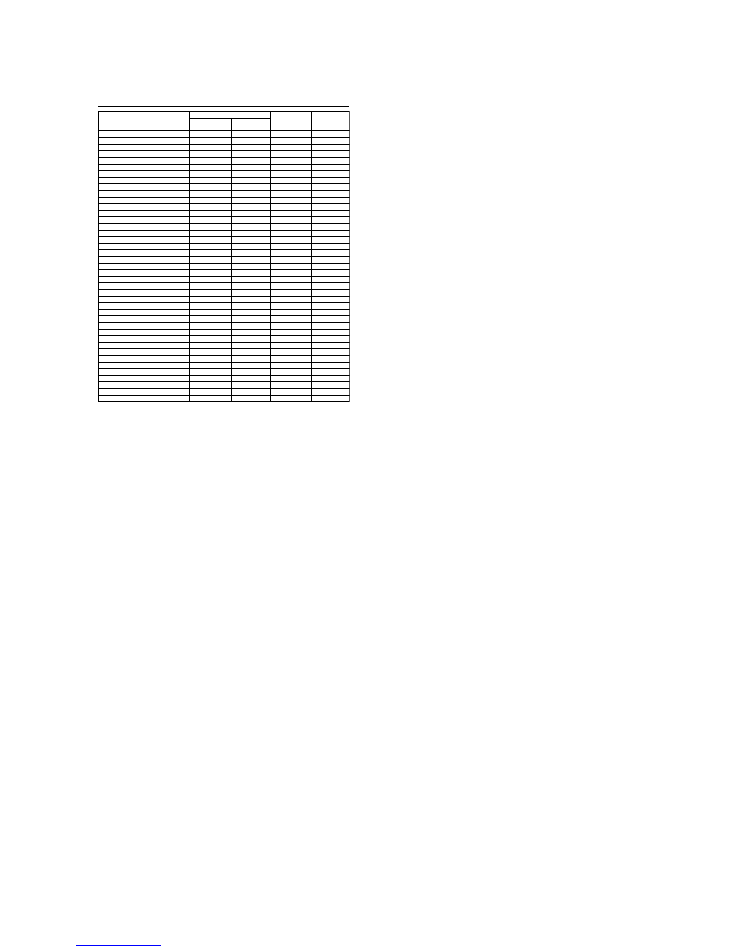
— 7 —
*
This watch does not support a GMT differential of +15.0.
•
Based on data as of 2003.
Anchorage
–9.0
–8.0
149
°
W
5:40
Bahamas
–5.0
–4.0
77
°
W
7:30
Baja, California
–7.0
–6.0
110
°
W
8:40
Bangkok
+7.0
+8.0
101
°
E
4:40
Boston
–5.0
–4.0
71
°
W
11:20
Buenos Aires
–3.0
–2.0
58
°
W
6:00
Casablanca
+0.0
+1.0
8
°
W
1:30
Christmas Island
+14.0
+15.0
(
*
)
158
°
W
4:00
Dakar
+0.0
+1.0
17
°
W
7:40
Gold Coast
+10.0
+11.0
154
°
E
8:30
Great Barrier Reef, Cairns
+10.0
+11.0
146
°
E
9:40
Guam
+10.0
+11.0
145
°
E
7:40
Hamburg
+1.0
+2.0
10
°
E
4:50
Hong Kong
+8.0
+9.0
114
°
E
9:10
Honolulu
–10.0
–9.0
158
°
W
3:40
Jakarta
+7.0
+8.0
107
°
E
0:00
Jeddah
+3.0
+4.0
39
°
E
6:30
Karachi
+5.0
+6.0
67
°
E
10:10
Kona, Hawaii
–10.0
–9.0
156
°
W
4:00
Lima
–5.0
–4.0
77
°
W
5:20
Lisbon
+0.0
+1.0
9
°
W
2:00
London
+0.0
+1.0
0
°
E
1:10
Los Angeles
–8.0
–7.0
118
°
W
9:20
Maldives
+5.0
+6.0
74
°
E
0:10
Manila
+8.0
+9.0
121
°
E
10:30
Mauritius
+4.0
+5.0
57
°
E
0:50
Melbourne
+10.0
+11.0
145
°
E
2:10
Miami
–5.0
–4.0
80
°
W
7:30
Noumea
+11.0
+12.0
166
°
E
8:30
Pago Pago
–11.0
–10.0
171
°
W
6:40
Palau
+9.0
+10.0
135
°
E
7:30
Panama City
–5.0
–4.0
80
°
W
3:00
Papeete
–10.0
–9.0
150
°
W
0:10
Rio De Janeiro
–3.0
–2.0
43
°
W
3:10
Seattle
–8.0
–7.0
122
°
W
4:20
Shanghai
+8.0
+9.0
121
°
E
1:20
Singapore
+8.0
+9.0
104
°
E
10:20
Sydney
+10.0
+11.0
151
°
E
8:40
Tokyo
+9.0
+10.0
140
°
E
5:20
Vancouver
–8.0
–7.0
123
°
W
5:10
Wellington
+12.0
+13.0
175
°
E
4:50
Site/Lunitidal Interval Data List
GMT Differential
Lunitidal
Site
Standard
DST/
Longitude
Interval
Time
Summer Time
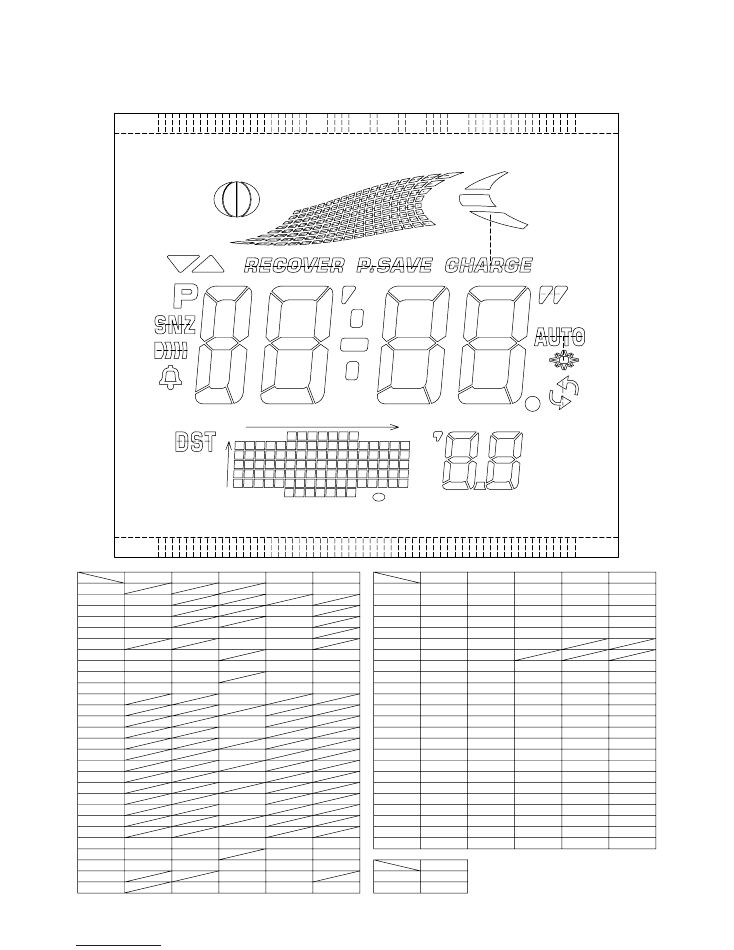
— 8 —
3. DRAWINGS: MODULE QW-2960
3-1. LCD DIAGRAM
L 6
L 7
L 8
L 9
L10
L11
L12
L13
L14
L15
L16
L17
L18
L19
L20
L21
L22
L23
L25
L26
L27
L 4
L24
L31
LC2
LC3
LC4
LC5
L 5
SEG
COM
LC1
L 1
L 3
L 2
X5Y5
X5Y6
REPEAT
AUTO
c0
b0
MID
HYP0
col1
MIN
X12Y5
col0
c4
b4
X11Y5
X11Y6
d4
g4
a4
X10Y5
X10Y6
NAMI7
NAMI6
NAMI5
NAMI4
NAMI3
NAMI2
NAMI1
NAMI0
e4
f4
RECOVER
X9Y5
X9Y6
c5
b5
X8Y5
X8Y6
d5
g5
a5
X7Y5
X7Y6
e5
f5
X6Y5
X6Y6
UP
M3
SNZ
PM
DOWN
M2
ALM
M1
SIG
M0
DST
HIGH
L55
L32
L33
L48
L47
L46
L45
L44
LC2
LC3
LC4
LC5
L36
L43
L42
L41
L40
L39
L38
L37
L35
L34
L49
L50
COM
SEG
L30
L51
L28
L54
L53
L52
L29
SEG
COM
LC1
LOW-CHARGE
P.SAVE
X0Y1
X0Y5
X0Y4
X0Y3
X0Y2
f0
b2
h0
e0
d2
a2
c1
b1
X4Y5
X3Y3
X3Y2
X3Y1
X3Y5
X3Y4
X2Y3
X2Y2
X2Y1
X2Y5
X2Y4
X1Y3
X1Y2
X1Y1
X1Y5
X1Y4
a1
e2
f2
g1
d1
YEAR
c3
b3
f1
e1
d3
g3
a3
e3
f3
X16Y3
X16Y2
X16Y1
X16Y4
X16Y5
X15Y3
X15Y2
X15Y1
X15Y4
X15Y5
X14Y3
X14Y2
X14Y1
X14Y4
X14Y5
X13Y3
X13Y2
X13Y1
X13Y4
X13Y5
X12Y3
X12Y2
X12Y1
X12Y4
POINT1
X11Y3
X11Y2
X11Y1
X11Y4
X11Y0
X10Y0
X9Y0
X8Y0
X7Y0
X6Y0
X5Y0
c2
X10Y3
X9Y3
X8Y3
X7Y3
X6Y3
X4Y3
X5Y3
X10Y2
X9Y2
X8Y2
X7Y2
X6Y2
X4Y2
X5Y2
X10Y1
X9Y1
X8Y1
X7Y1
X6Y1
X4Y1
X5Y1
X10Y4
X9Y4
X8Y4
X7Y4
X6Y4
X4Y4
X5Y4
g2
a0
POINT0
SEC
d0
g0
h0
a1
f1
g1
e1
d1
c1
b1
a0
f0
g0
e0
d0
c0
b0
a2
f2
g2
e2
d2
c2
b2
a3
f3
g3
e3
d3
c3
b3
a4
f4
g4
e4
d4
c4
b4
a5
f5
g5
e5
d5
c5
b5
PM
DOWN
MIN
M0
RECOVER
P.SAVE
AUTO
SEC
HYP0
LOW-CHARGE
HIGH
MID
SIG
ALM
Y6
Y0
X16
X0
POINT0
L55
L54
L53
LC4
L13
L11
L 2
LC5
L31
L32
L 3
L 4
L 5
L 6
L 7
LC2
LC3
L52
L 1
L 8
L51
L23
L30
L29
L28
L27
L26
L25
L24
L21
L20
L 9
L10
L14
L16
L18
LC1
L33
L34
L35
L36
L37
L38
L39
L40
L41
L50
L49
L48
L47
L46
L45
L44
L43
L42
YEAR
DST
SNZ
UP
M1 M2
M3
REPEAT
col0
col1
NAMI1
NAMI0
NAMI6
NAMI7
NAMI5
NAMI4
NAMI3
NAMI2
POINT1
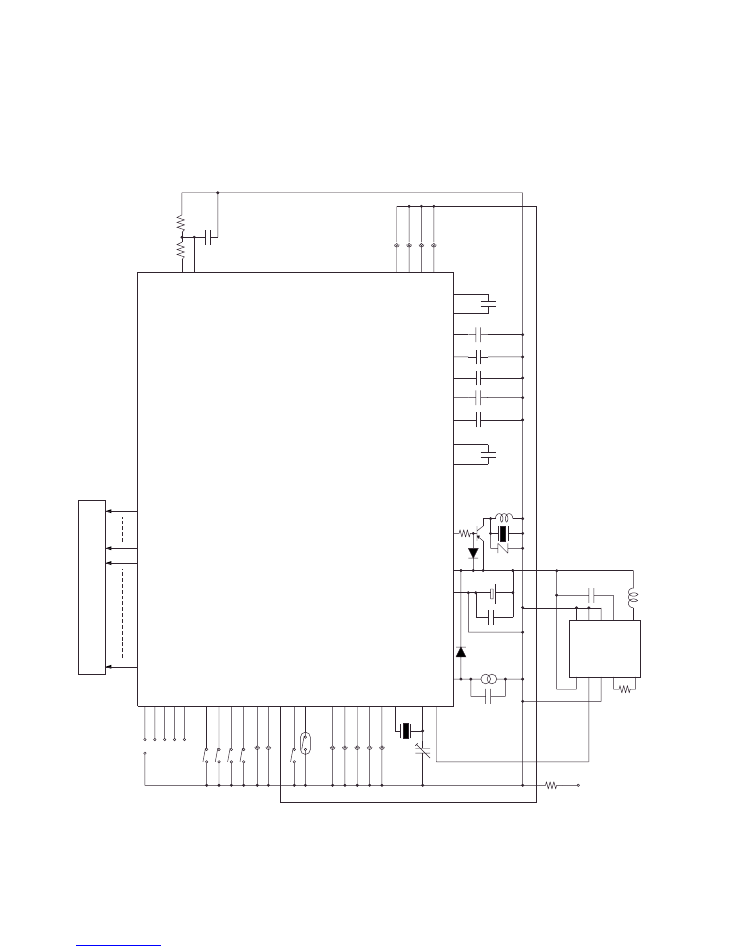
— 9 —
3-2. CIRCUIT DIAGRAM
GND
VDD2
BA
T
VCH
VDD3
VC1
VC2
C3
C2
C5
XTB
Xtal
L1 - - - - L55
L
C1 - - - LC5
CT
LCD
LD1
S2
S1
VDD1
C1
BD
C8
LL1
Tr
1
XT
T1
T2
T3
KI1
KI2
KI3
KI4
KI5
KI6
KI7
KI8
KI9
S3
SCR
SCIN
RP1
RP2
Cp
PZ
VDSP
C4
VC3
V
C4
Di1
VHF
C6
SDO
S
CK
CSB
AC
T4
KC4
KC3
KC2
KC1
R1
R2
VSC
C7
SC
C9
✽
4
✽
4
✽
1
R3
✽
4
✽
1
✽
1
Z
✽
3
✽
3
✽
3
SK
✽
3
VPM
Di2
R1
✽
5
✽
6
Rb
GNDB
✽
7
✽
1
SA
S4
SDI
✽
1
N1
N2
✽
8
✽
8
✽
3
✽
3
✽
9
✽
2
✽
2
✽
2
✽
2
✽
2
✽
2
INV
LL2
VCC
Rel
ENB
GND
RT
1
RT
2
NC
NC
NC
ELD
CIL
EL
BACK
FRONT
✽
10
✽
11
✽
1. No
bonding
✽
2. KC1-KI7:
Short
(Soldering)
KC2-KI7:
Open (No Soldering)
KC3-KI7:
Open (No Soldering)
KC4-KI7:
Open (No Soldering)
GND-KI6:
Open (No Soldering)
✽
3.
Latch type key
✽
4.
Short (Soldering) (R trimming)
✽
5. Inclination
sensor
✽
6.
2.8V 1/5 Duty 1/3 Bias LCD
✽
7.
GNDB is used for the bias on the back of the tip.
✽
8.
Short (Soldering) (N trimming)
✽
9.
L28~L30 are used as static drive terminals.
✽
10.
KC2 is used in this module.
✽
1
1.
KC3 is used in this module.
LSI
TOTAL 106PINS
BONDING 101PINS
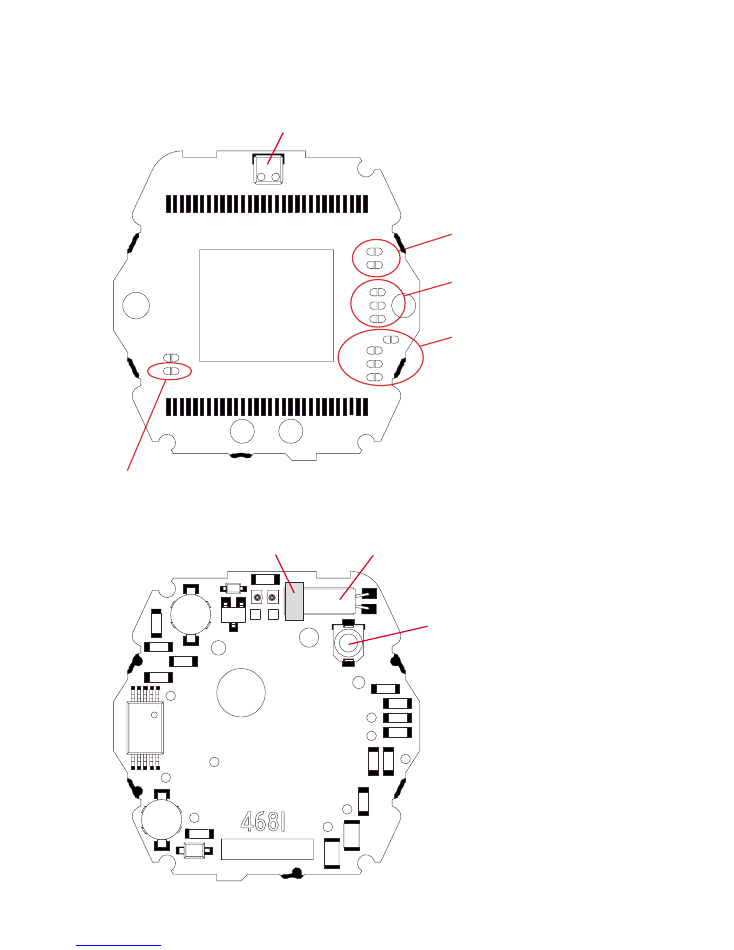
— 10 —
3-3. CHECKING TERMINALS AND COMPONENTS
SENSOR/TILT
(71055275)
CUSHION 6
(72110064)
Short pad for N trimming
Short pad for R trimming
Short pad for switching modules
Short pad for switching modules
OSCILLATOR/CRYSTAL
(71106323)
CAPACITOR/TRIMMER
(10010950)
11. PCB ASS'Y
(76408729)
N2
GND
N1
GND
GND
R1
KC3
KI7
KC2
KI7
KC1
GND
R3
GND
R2
VSC
KC4
KI7
KI6
GND
GND
KI5
GND
ELD
VDD2
KI7
VDD2
BDB
BD
BDB
GND
L
GND
SCIN
SCR
SCIN
RT2
RT1
VSC
GND
GND
VDD1
GND
VDD3
GND
VHF
GND
VDSP
VDD2
CIL
ELD
GND
GND
GND
RT
1
GND
RT
2
VSC
VDD2
GND
L
GND
SCIN
GND
CIL
VDD2
VDD2
GND
VC1
VC2
VC4
VC3
GND
GNDB
VCH
GND
XT
XTB
GND
KI9
BDB
VDD2
L
VSC
VDD2
VCH
VC1
VDSP
AC
ELD
LD1
L
XT
KI9
KI3
KI8
KI1
KI4
KI2
VDD2
GND
GND
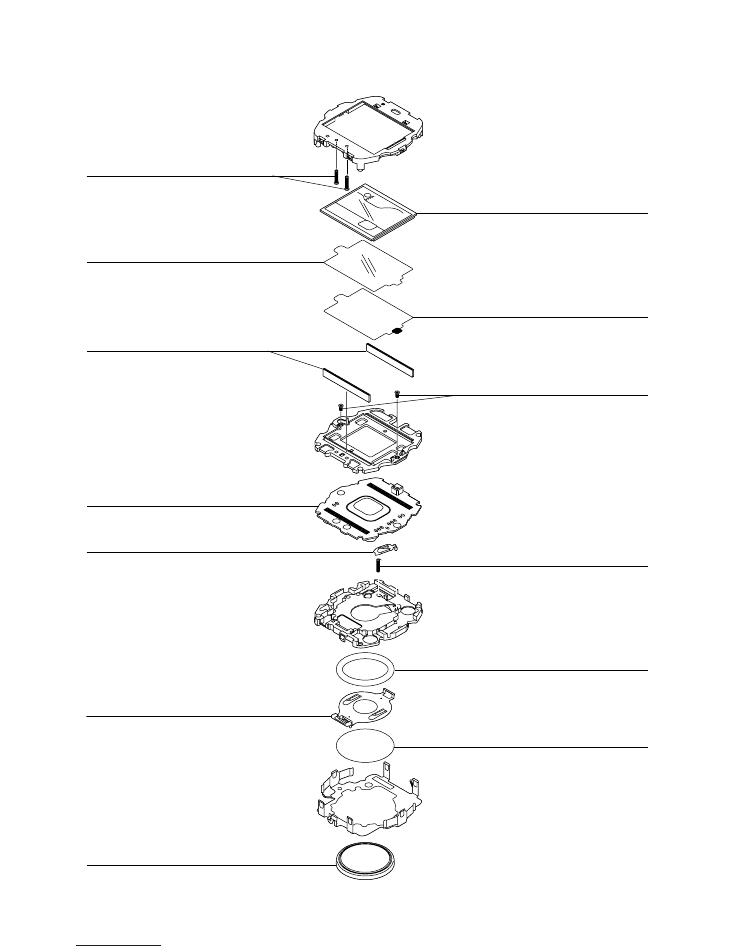
— 11 —
4. EXPLODED VIEW: MODULE QW-2960
3 (72311913)
17 (10106533)
6 (10083364)
11 (76408729)
PCB ass'y
16 (10106532)
15 (72019249)
13 (10099862)
9 (10189345)
5a (10106538)
5b (10189346)
5c (10106539)
8 (10065664)
14 (10106530)
1 (10065657)
Battery Storage (CTL1616)
7 (10106531)
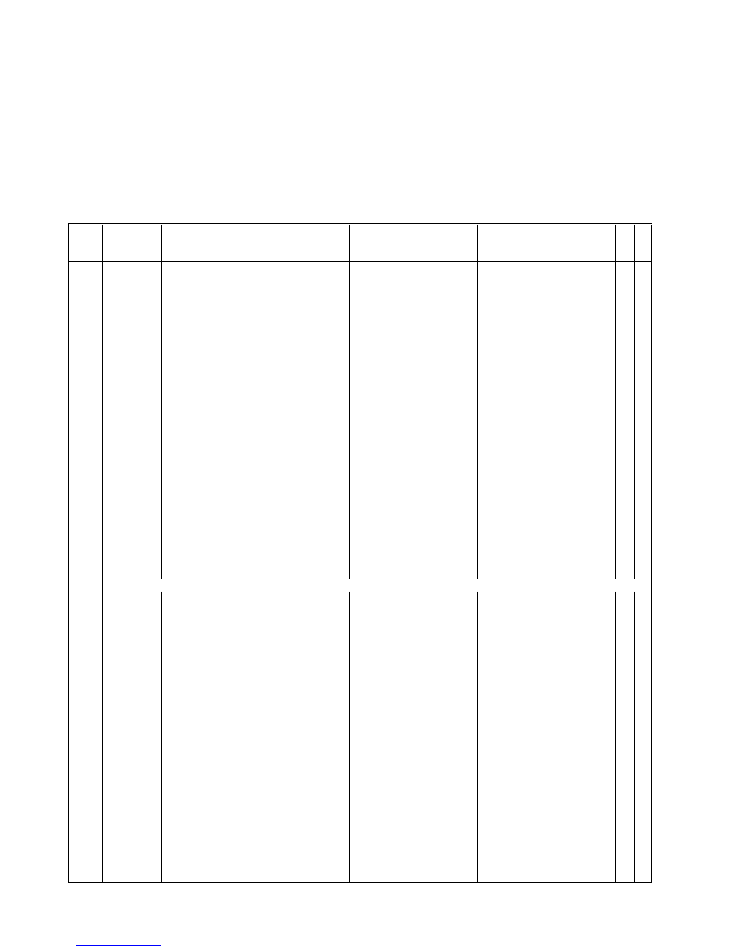
5. PARTS LIST: MODULE QW-2960
Note: 1. Prices and specifications are subject to change without prior notice.
2. Spare parts are classified as follows according to their importance in after-sales service.
A Rank ---------------------------------------- Very Important
B Rank ---------------------------------------- Important
C Rank ---------------------------------------- Less important
3. Batteries in Bulk pack on the tray will be supplied from our Overseas Spare Parts Section under charge basis.
Batteries in Blister pack will be supplied from our Sales Department.
4. As for order/supply of spare parts, refer to the separate publication "GUIDE BOOK for spare parts supply".
Item
Code No.
Parts Name
Specification
Applicable
Q R
76408734 MODULE/WITHOUT MOVEMENT
QW-2960AT-01TK
BGX-260-1/5
1
A
76408735 MODULE/WITHOUT MOVEMENT
QW-2960AT-02TK
BGX-260-2A/2B
1
A
76408736 MODULE/WITHOUT MOVEMENT
QW-2960AT-03TK
BGX-260-4
1
A
1
10065657 BATTERY/STORAGE
CTL1616
QW-2960AT Common
1
B
2
10010950 CAPACITOR/TRIMMER
CTZ2E-30C-W2-P
QW-2960AT Common
1
B
3
72311913 CONTACT/BATTERY(-) 1828
Q359948B-2
QW-2960AT Common
1
C
4
72110064 CUSHION 6
Q4914A-1
QW-2960AT Common
1
C
5a
10106538 EL
YEL-2611-A-00
QW-2960AT-01TK
1
A
5b
10189346 EL
YEL-2611-A-20
QW-2960AT-02TK
1
A
5c
10106539 EL
YEL-2611-A-60
QW-2960AT-03TK
1
A
6
10083364 HOLDER/BATTERY 2154
Q254197A-2
QW-2960AT Common
1
C
7
10106531 INTERCONNECTOR/ 2611
Q470668-1
QW-2960AT Common
2
C
8
10065664 LABEL/ 2368
Q468543A-1
QW-2960AT Common
1
C
9
10189345 LCD
K2960-01THP
QW-2960AT Common
1
A
10
71106323 OSCILLATOR/CRYSTAL
DT-26S11
QW-2960AT Common
1
B
11
76408729 PCB ASS'Y
Q256046*4TK
QW-2960AT Common
1
A
12
71055275 SENSOR/TILT
TS-2418-P
QW-2960AT Common
1
B
13
10099862 SHEET/INSULATION 2620-1
Q470524-1
QW-2960AT Common
1
C
14
10106530 SPACER/ 2611-2
Q470667-1
QW-2960AT Common
1
C
15
72019249 SPRING/COIL 675-3
Q413389A-1
QW-2960AT Common
1
B
16
10106532 SPRING/COIL 2611-1
Q470669A-1
QW-2960AT Common
2
B
17
10106533 SPRING/COIL 2611-2
Q470687-1
QW-2960AT Common
2
B
For the prices and minimum order/supply quantities of the above parts, refer to the Parts Price List P.P.L.-620.
Notes: Q - Used quantity
R - Rank
— 12 —
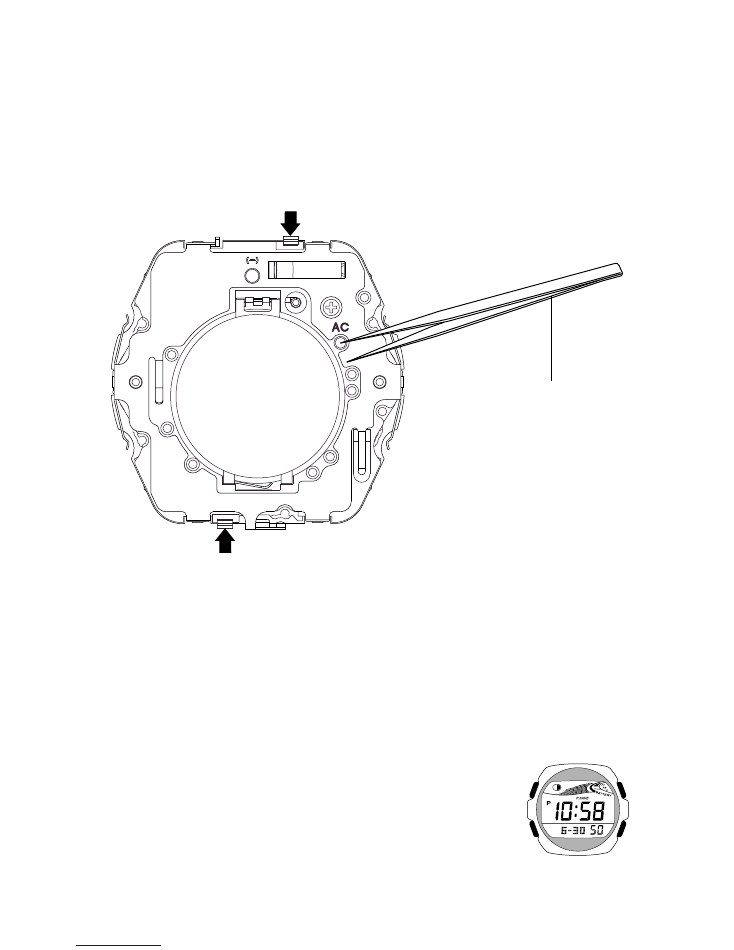
— 13 —
6. PRECAUTIONS FOR REPAIR: MODULE QW-2960
6-1. AC (ALL CLEAR) AND REMOVING OF MODULE
1. Perform AC (ALL CLEAR) when inserting a new battery, or else the memories and/ or counters may give
erratic displays.
Touch the AC contact and the positive (+) side of the battery or main plate with the metallic tweezers.
The contact should be made for about two seconds.
2. On removing of the module from the case, please insert the precision screw driver between the module
and the case pointed by arrows.
6-2. ACCURACY CHECKING
Check the accuracy of the module with the quartz timer after switching the module to “ACCURACY
CHECKING MODE”.
The operations are shown below:
A) SWITCHING TO “ACCURACY CHECKING MODE”
While pressing the
D
button, press
A
and
C
buttons at the normal timekeeping mode.
Then all the segments are displayed and the LCD drive signals are changed to the static drive signal
of “32 Hz” so that you can check the accuracy with the quartz timer.
B) CANCELLATION OF THE “ACCURACY CHECKING MODE”
Press any button, except for
D
button.
Then the display is returned to its original state.
NOTE:
The “ACCURACY CHECKING MODE” will
automatically return to the regular mode
in 1 ~ 2 hour(s) without any operation.
Metallic tweezers
QW-2960
A
C
B
D
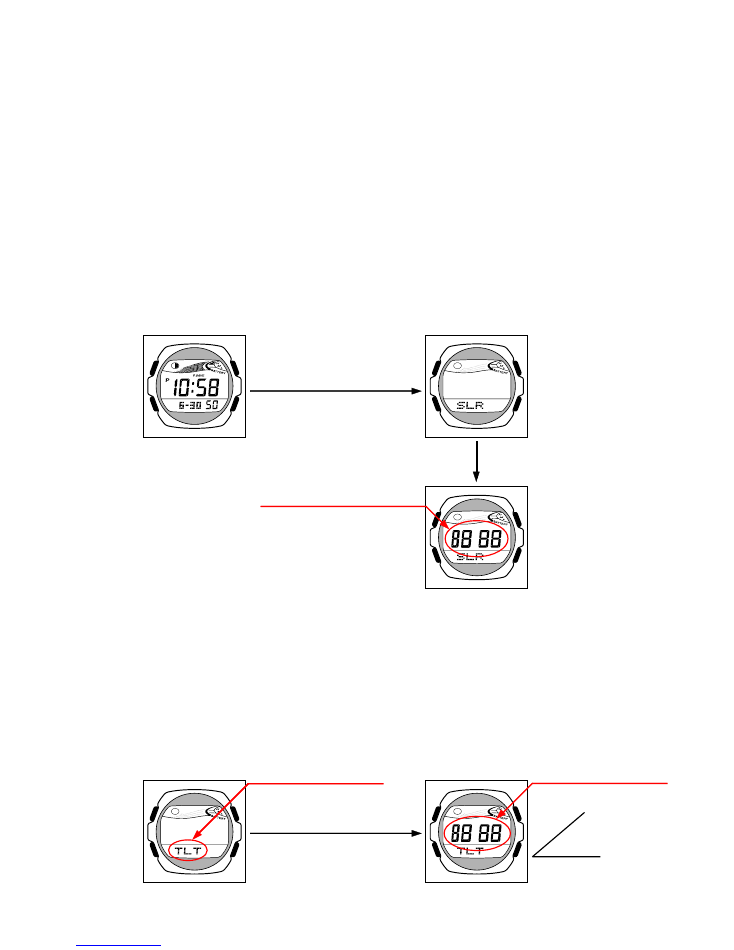
— 14 —
6-3. SOLAR CELL-PCB ASS'Y CONTACT CHECKING
Check a Solar cell and PCB ass'y are contacted correctly by contact spring, when a module is
disassembled.
1.
To enter TEST mode.
1) While pressing
D
button, press
A
and
B
buttons at the normal timekeeping mode.
2.
Check a Solar cell and PCB ass'y contact in the following order.
1) Display side up and place the watch on the desk.
2) Check the display indicates as figure 2.
3) Display side down and place the watch on the desk more than two seconds.
Or go to a dark room and place the watch more than 5 seconds.
4) Check the display indicates as figure 3.
If "8888" is not appeared on the display, disassemble again the module and check the contact
spring between the Solar cell and PCB.
3.
To exit from TEST mode
Press any button.
6-4. HOW TO CHECK TILT SENSOR
1) Press
A
,
B
and
C
buttons at the normal timekeeping mode.
2) Check the display indicates as figure 4.
3) Tilt the watch towards you more than 40 degrees.
4) Check the display indicates as figure 5.
Figure 4
Figure 5
Figure 3
Figure 1
Figure 2
Press
D
,
A
and
B
buttons
Tilt the watch towards you
more than 40
°
More than 40
°
D
B
C
A
Place the watch in a dark
room more than 5 seconds.
Appear "8888" on display.
Appear "TLT" on display.
Appear "8888" on display.

CASIO COMPUTER CO.,LTD.
Overseas Service Division
6-2, Hon-machi 1-Chome
Shibuya-ku, Tokyo 151-8543, Japan